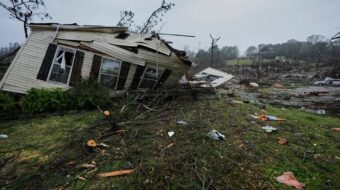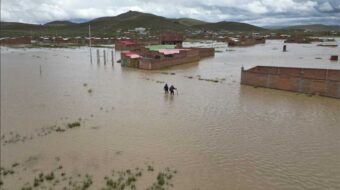
SAND SPRINGS, Okla. (AP) — Storm-weary residents in Oklahoma were gutting waterlogged homes Sunday as the Arkansas River continued its slow crest rolling hundreds of miles downstream, even as many kept a cautious eye on this week’s weather forecasts showing more rain.
In the Tulsa suburb of Sand Springs — among the first communities inundated when the U.S. Army Corps of Engineers started releasing more water from a dam upriver to control more severe flooding elsewhere — soggy couches and recliners and dumpsters full of carpet, drywall and insulation lined residential streets covered in silt deposited by floodwaters.
Jamie Casto was helping clean up the house where her 65-year-old uncle has lived for 14 years.
Though Casto, 35, said her uncle didn’t have flood insurance because he was told he lived in a 500-year floodplain, a rust-colored line 4 feet from the concrete floor of the garage clearly marked how high water had gotten before they were able to get into the house Friday.
Casto is trying to help her uncle fill out paperwork to apply for emergency loans to help get the house back in order.
She gave Democratic presidential candidate Beto O’Rourke a tour of the home while he was in historically red Oklahoma to see damage firsthand. The former Texas congressman said that if he is elected, his plan would include federal grants to invest in communities before disasters strike because the planet is warming and fires, storms and floods are expected to get worse.
“We know there’s going to be more of this — more severe, more devastating,” O’Rourke said. “We need to invest in communities now.”
Cleanup won’t be fast or easy. The Tulsa Area Emergency Management Agency put out a call for volunteers last week, with caveats that volunteers must bring their own gloves and boots. The Tulsa Health Department also gave free tetanus vaccinations to volunteers.
The National Weather Service said that in Tulsa, the river was at just over 13 feet (4 meters) Sunday morning, 10 feet (3 meters) lower than its high point on Wednesday.
On Saturday, President Donald Trump declared a major disaster in Oklahoma and made federal funding available to Muskogee, Tulsa, and Wagoner counties, which have been hit by flooding, tornadoes and other storms. Across the state, officials said six people died and 118 were injured from the severe weather this spring.
As the high waters travel southeast, officials in Dardanelle, Arkansas, where a levee breached, said the risk of widespread flooding has abated, though communities further downstream aren’t out of danger yet.
Dardanelle Mayor Jimmy Witt said in a Facebook post Saturday night that he thought the city of about 4,700 people “will be ok” after the flow of water toward the community began to slow.
Witt had previously warned the city could be inundated after the river on Friday made a 40-foot (12-meter) hole in a levee in Dardanelle, which is roughly 100 miles (160 kilometers) upstream from Little Rock.
Officials said Saturday that they were constructing a temporary levee, calling it a “last-ditch effort” to shore up the city’s southern border and predicting that up to 800 homes could be affected by creeping floodwaters. The threat decreased hours later as the flow of water slowed.
By Sunday morning, Dardanelle appeared to be safe. Yell County Office of Emergency Management Director Jeff Gilkey said the river never reached the temporary levee. But Gilkey and Witt warned that more rain could reverse the city’s fortunes.
National Weather Service meteorologist Dennis Cavanaugh said possible rain in Oklahoma would likely prolong flooding along the Arkansas River, though it probably wouldn’t raise water levels higher than where they crested. Most areas will see the threat of major flooding subside within a few weeks, although the river will likely stay very high through June, Cavanaugh said.
Arkansas is expected to get more rain later in the week, which would increase the likelihood of flash-flooding.
“Normally, the waters would drain pretty quickly into the Arkansas River,” he said, but with the river flooded, water will have nowhere to go.
Downriver communities were preparing Sunday for record-breaking crests. Officials ordered mandatory evacuations for about 500 homes that sit within the levee system in Jefferson County, just southwest of Little Rock. The county’s emergency management director, Karen Blevins, said the evacuation was precautionary and officials have no concerns about the levees.
In North Little Rock, which sits across the river from the capital city, officials went door-to-door Saturday to urge residents in about 150 homes near the river to consider leaving.
___
Grabenstein reported from Little Rock, Arkansas.












